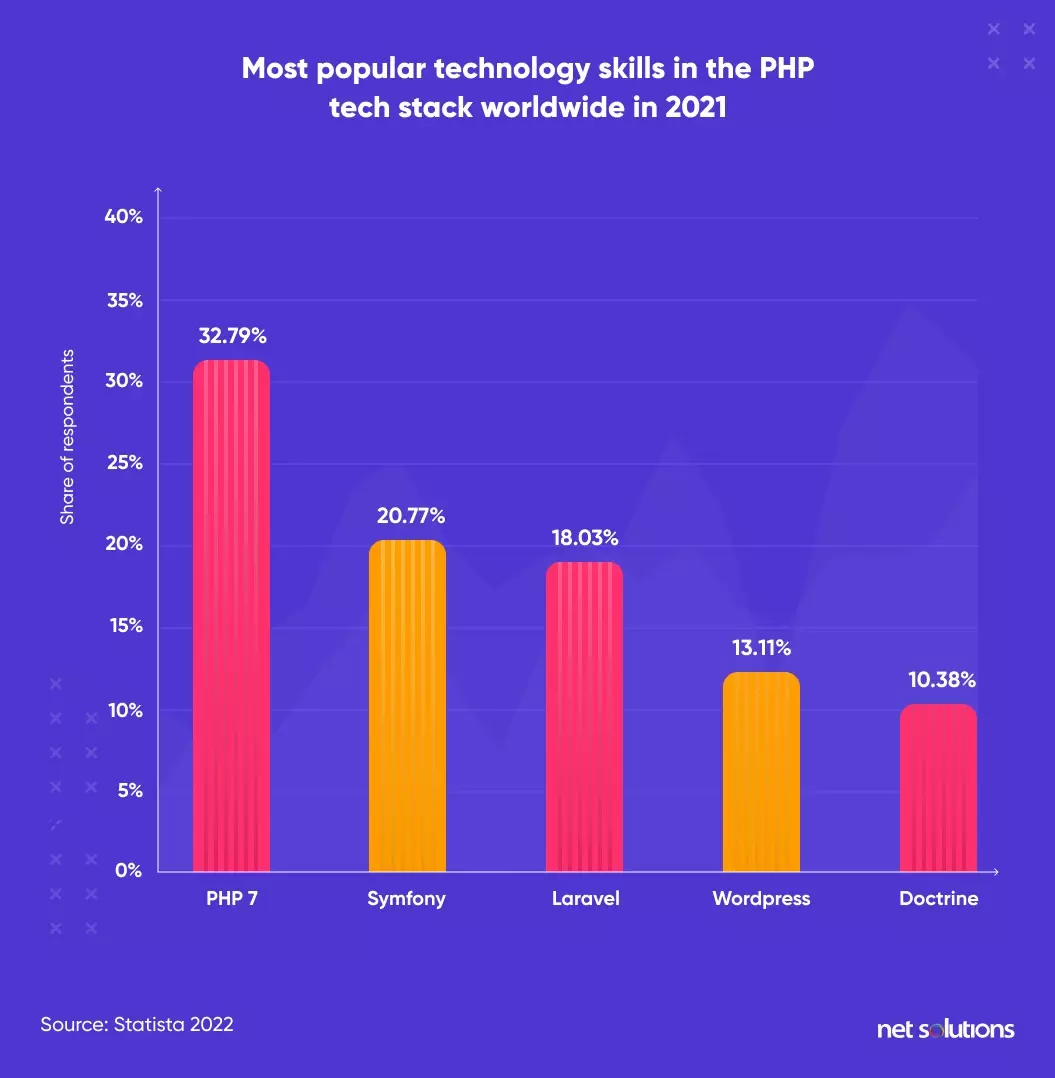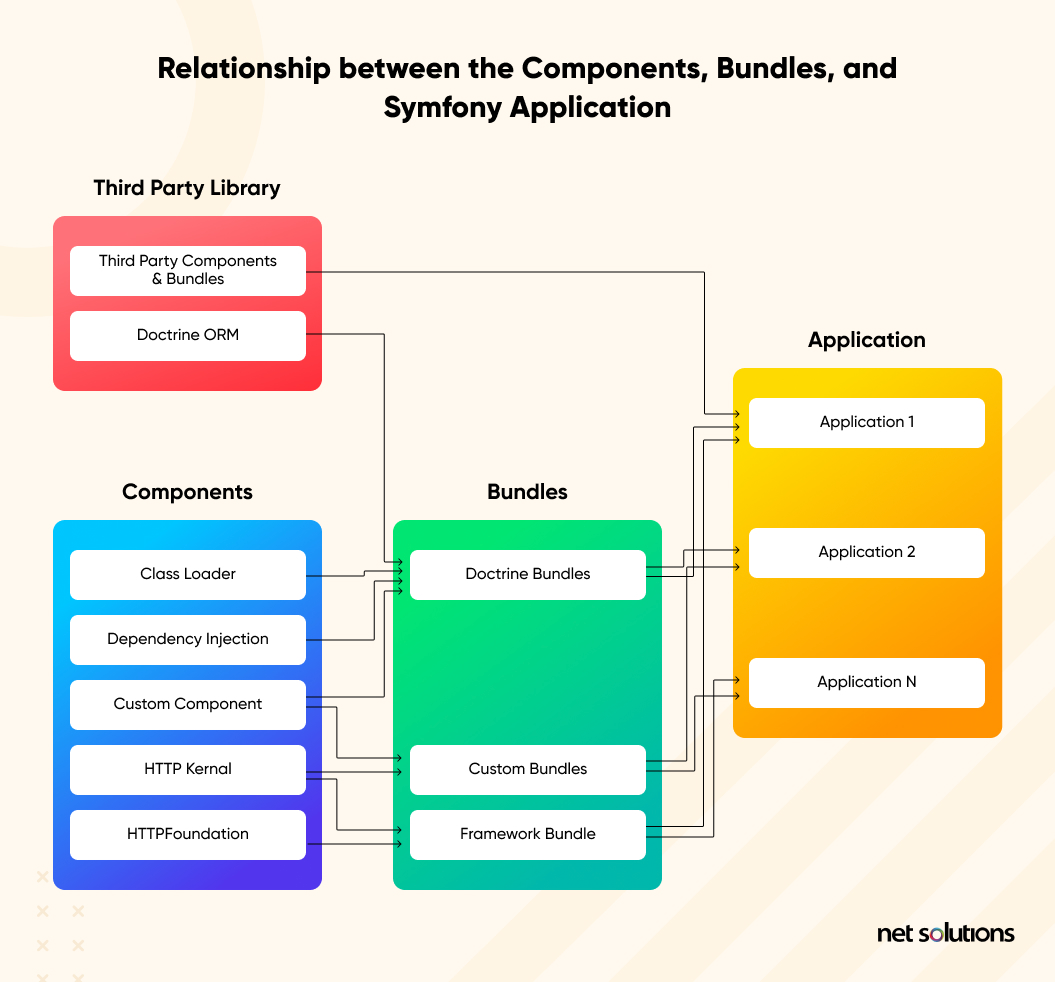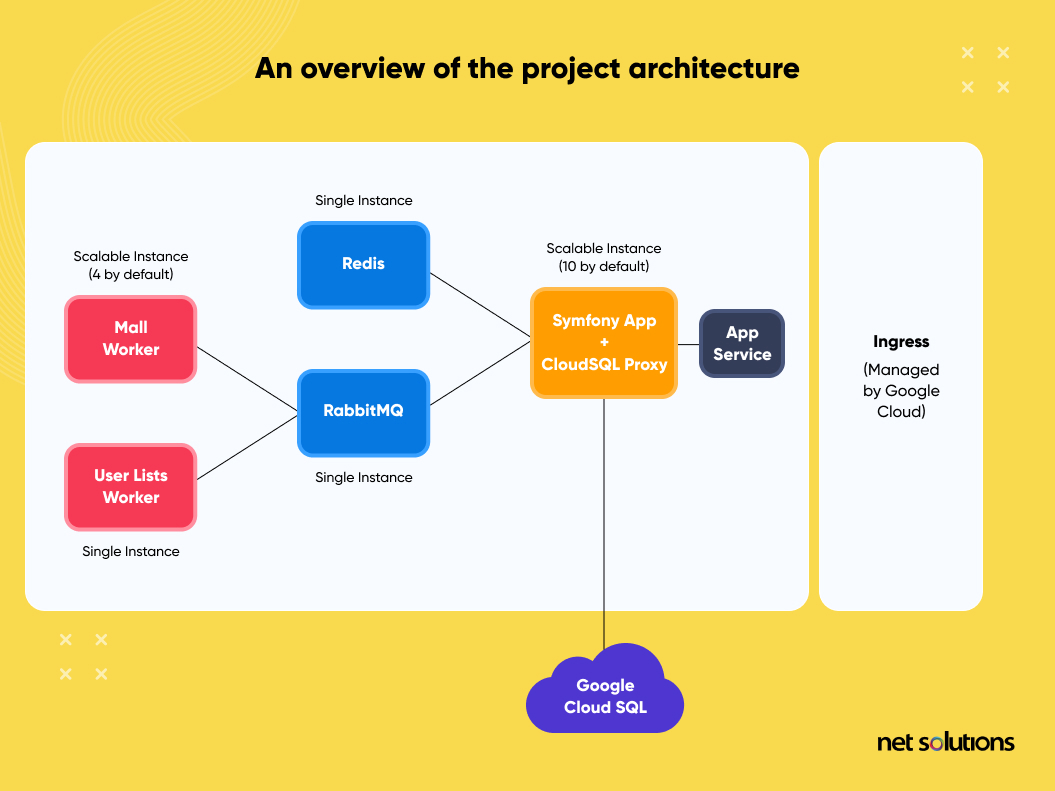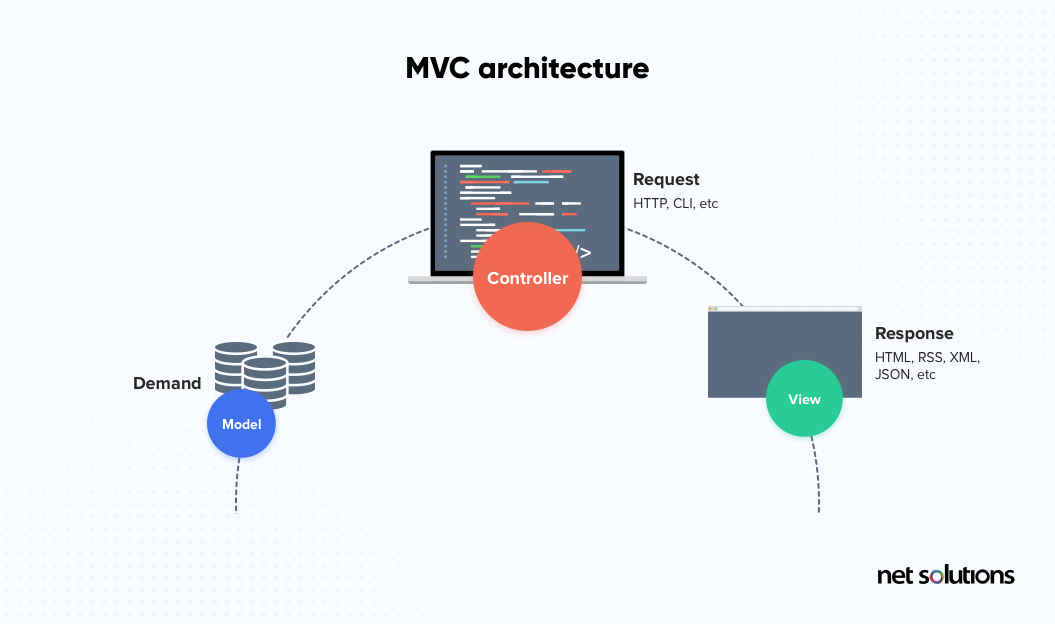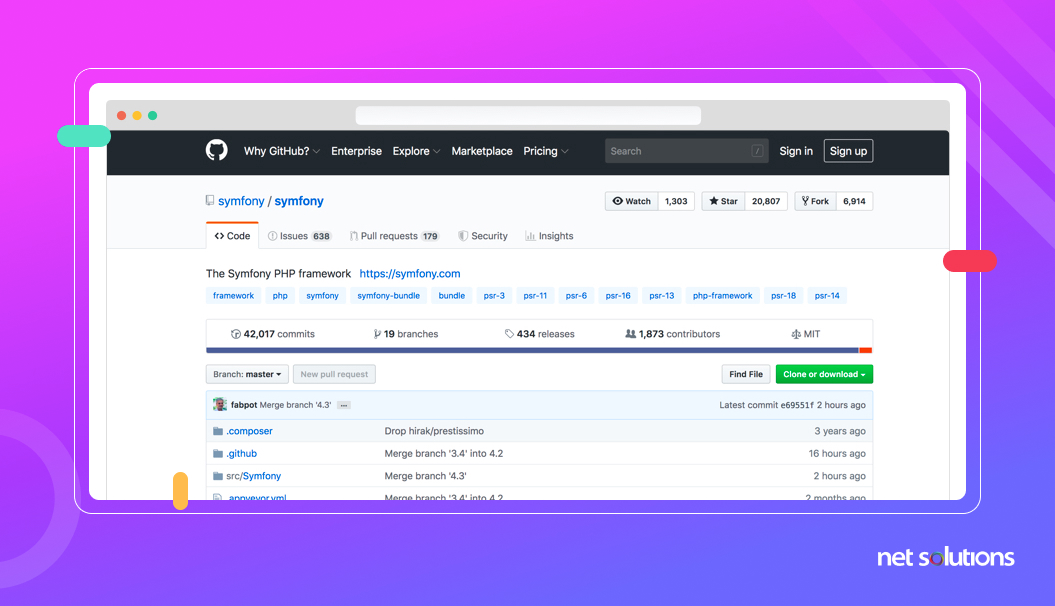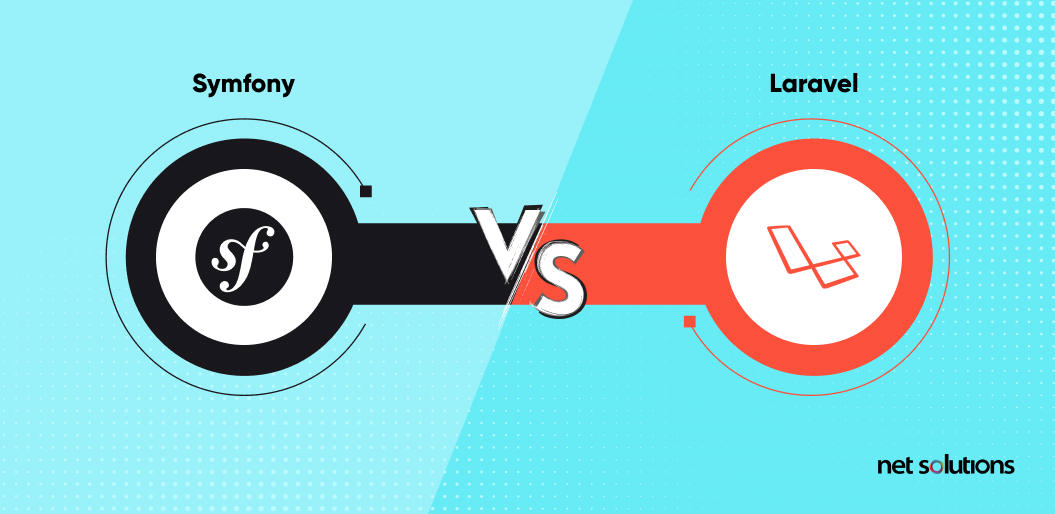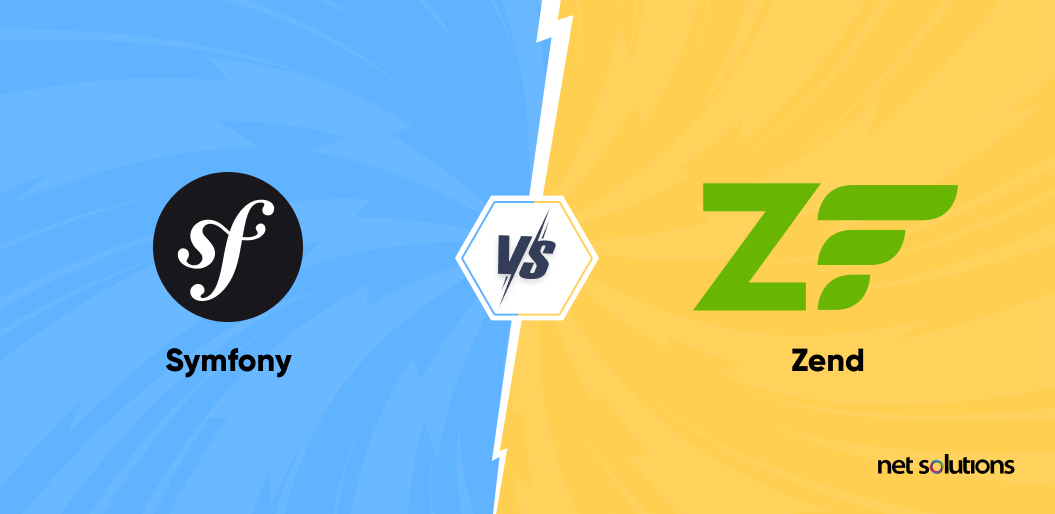Summary: Symfony is an open-source PHP web app framework for developers seeking a simple and elegant toolkit for building full-featured web applications. It works with an independent library and the PHP Unit. This article will help you understand why symfony framework is the preferred choice for PHP development. Let’s read.
Choosing the right web development framework is one of the vital steps toward building a web solution. PHP has evolved rapidly and is presently being used extensively for producing simple and complex web applications.
Today, 79% of all the websites in the world are created with the PHP programming language. A web application can be built either in pure PHP or one of its frameworks.
Symfony has grown exceptionally in recent years. The graph below shows that over 20% of businesses are using theSymfony web framework to web applications in PHP.
Symfony is heavily influenced by the web application frameworks Ruby on Rails, Django, and Spring. Many open-source projects use its components, including Composer, Drupal, and phpBB. Symfony’s comprehensive documentation and active community make it an excellent resource for developers looking to build high-quality PHP web applications.
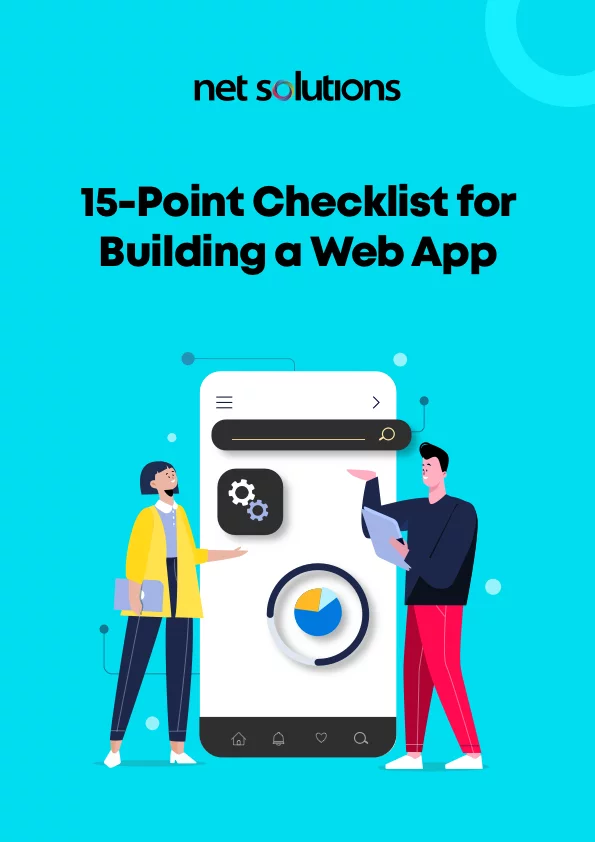
We respect your privacy. Your information is safe.
What is the Symfony Framework?
“Symfony is a set of PHP Components, a Web Application framework, a philosophy, and a community — all working together in harmony.” (Symfony Website)
Generally speaking, the Symfony framework is flexible and does away with cumbersome coding, thus saving development time. The philosophy behind Symfony is to help create software that streamlines the entire product development process for the developers.
Symfony has all the characteristics that are expected from a modern framework. This blog lists some features that make Symfony framework one of the best PHP frameworks.
Is Symfony framework frontend or backend?
Symfony is a feature-rich back-end framework that is used to build complex applications. The framework provides a range of tools and features specifically designed for building scalable PHP web applications, including support for multiple environments and a robust caching system. Many developers still prefer the lightweight Silex micro-framework or the Symfony MicroKernel, and Symfony is a widely used application framework among open-source developers.
Why Symfony: 5 Reasons to Choose the Framework for PHP Development
1. High Flexibility
The Symfony PHP framework is a well-organized, feature-rich PHP framework whose architecture paves the way for developers to build sustainable web applications in the easiest way possible which further enhances the users’ experience.
This PHP framework is incredible because of its two most striking technological benefits: Bundles and Components.
- The Bundle is similar to a plugin. The primary benefit of Bundles is that they are decoupled, which implies they can be reused and reconfigured further for many applications to bring down the overall development cost.
- Components help reduce routine tasks as they can be used independently by adding your custom modules without hurting the architecture. All-in-all, 30 helpful Symfony components facilitate the web development process. The components of the Symfony framework can also be used exclusively in other frameworks (for instance, Laravel) or simple PHP solutions.
Bundles and Components help to eliminate the inflexible dependencies in the architecture by giving you the liberty to get reused. Fewer the dependencies, the easier it becomes to introduce changes sans the risk of breaking other parts of the system.Thus, you can adapt the solution to any requirements and user scenarios to create a highly flexible application.
2. Customization
The Symfony framework is packed with exclusive custom features and functionalities for developers and businesses. With Symfony as your PHP framework, you can make your web application as user-oriented as you aim for. The advanced OOPS service architecture of Symfony allows to scale up projects.
Symfony offers the following types of customization:
- Full-stack – Build a complex product with multiple functionalities
- Brick by brick – You can create your custom framework if you wish to build an application with specific features and selective functions.
Symfony Development: The Unsung Hero of the Emmanuel Macron’s Political Campaign
The President of France, Emmanuel Macron in April 2016, came up with a political movement called “En Marche!” (“On the Move” in English). It was launched to ask the public what was wrong with France. Surprisingly, En Marche! was low on budget, infrastructure, or members to support its cause. The internet was the only weapon to support and promote their campaign and collect collections. Initially, their platform was built upon WordPress. They found it to be too slow for them. They needed another platform to replace WordPress, which could allow faster and more customized development. Thus, they chose Symfony as their primary framework.
“The choice of Symfony was natural: it fits the project size well, I have experience with it and it scales easily to handle the large number of users we have.”
-Titouan Galopin, Product Lead at EnMarche project
3. Refined MVC Architecture
The MVC architecture of the Symfony framework is ideal for systematic and scalable web development projects. Utilizing MVC as the core of its web development, the Symfony framework makes sure that the project has an organized file structure distributed into Model, View, and Controller.
- The Model – focuses on the business logic of the web application.
- The View – provides the specific model into a web page visible to the user.
- The Controller – as per the user actions, prompts alterations to the Model or View when needed.
The true benefit of using MVC with Symfony is that the developers get the liberty to easily separate the Model (business logic) and View (user presentation), allowing for better maintainability.
4. Large community
This is one of the critical aspects that define the framework’s survivability and stands good. Symfony’s official website declares 3000+ contributors with a passionate group of over 600,000 developers from more than 120 countries – the number is several times bigger than that of other PHP framework communities. Moreover, when writing this article, the Symfony framework has 20,758 stars and 1,304 watchers and has been forked 6,901 times on Github.
Why strong community matters
Symfony PHP framework is an open-source framework giving liberty to PHP experts from all corners of the world to take part in making the code better for everybody. In the community, people cooperate in building new components to solve emerging issues or help others with advice. Understandably, as the community strength grows, so does the support ecosystem and the rate of innovation.
Why Dailymotion Migrated to Symfony
Initially, the website of Dailymotion was built upon their homemade framework. They had sufficient in-house developers dedicated to their website development. However, they wanted to shift their focus on their business rather than being forced to maintain a framework.
Thus, they migrated to an open-source framework—Symfony, and they chose it because of its large community. The other main reasons for their shift, as mentioned by their co-founder Olivier Poitrey were – maintaining less code, better compliance with coding conventions, and easy access to new processes like unit/functional testing.
5. Stable and Sustainable
Fortunately, Symfony is one of the few commercially supported frameworks. Developed and sponsored by SensioLabs, it offers 3-year support for all the major versions. Moreover, the company also provides lifetime support for security-related issues and offers official tutorials and certification. The company’s website will help you to find the upcoming conferences taking place all over the world. Thus, the scale and seriousness of their intentions and beliefs can be inferred.
Symfony Architecture: Decoding Various Components of the PHP Framework
Symfony components are independent PHP libraries that provide unique functionality in any PHP application. Currently, the Symfony framework contains more than 30 high-quality components. Let’s take a look at how Symfony components are used:
Symfony Framework Components
- Finder
The Finder component uses an intuitive fluent interface to find files and directories based on various criteria (name, file size, modification time, and so on). The component includes a plethora of methods for defining search criteria. Because they all implement a fluent interface, they can all be chained. - Filesystem
The Filesystem component offers platform-independent utility for file system operations and file/directory path manipulation. It includes essential filesystem utilities. - ClassLoader
If your project classes adhere to standard PHP conventions, this component will automatically load them. This component has been considered obsolete since Symfony 3.3; instead, use Composer class loading. - DependencyInjection
The DependencyInjection component implements a PSR-11 compatible service container, allowing you to benchmark and centralize the way elements are built into your application. - EventDispatcher
The EventDispatcher component provides tools for your application components to communicate with one another by dispatching and listening to events. To make all of this possible and your projects genuinely extensible, the Symfony EventDispatcher component implements the Mediator and Observer design patterns. - Serializer
The Serializer component converts objects into a specific format (XML, JSON, YAML, etc.) and vice versa. - ExpressionLanguage
The ExpressionLanguage component includes an engine for compiling and evaluating expressions and is a one-liner that returns a value. - Workflow
The workflow component allows you to define a process or a life cycle for your object in an object-oriented manner. Each step is called a place, and you also define transitions, which describe the action taken to move from one place to another. - HttpFoundation
The HttpFoundation component defines the HTTP specification’s object-oriented layer. An object-oriented layer replaces the default PHP global variables and functions in the Symfony HttpFoundation component. - Form
Forms can be created, processed, and reused using the Form component.The Form component is a tool that can assist you in resolving the issue of allowing end-users to interact with and modify data in your application. - HttpKernel
Using the EventDispatcher component, the HttpKernel component provides a structured process for converting a Request into a Response. It’s versatile enough to be used to build a full-stack framework (Symfony), a micro-framework (Silex), or a refined CMS system (Drupal). - Routing
When your application receives a request, it invokes a controller action to produce a response. The routing configuration specifies which action should be performed for each incoming URL, and it also offers the ability to generate SEO-friendly URLs.
Symfony Framework Bundle
A Symfony bundle is a collection of files and folders that have been organized in a specific way. The bundles are designed to be reusable across multiple applications, and the main application is packaged as a bundle, commonly referred to as AppBundle.
A bundle can be packaged specifically for an application, for example, AdminBundle (admin section), BlogBundle (site’s blog), etc. Such bundles cannot be shared across applications. Instead, we can model a specific part of the application, such as blogs, as a generic bundle that can be copied from one application to another to reuse the blog functionality.
- Controller − All controllers need to be placed here.
- DependencyInjection − All dependency injection-related code and configuration need to be placed here.
- Resources/config − Bundle-related configurations are placed here.
- Resources/view − Bundle-related view templates are placed here.
- Resources/public − Bundle-related stylesheets, JavaScripts, images, etc., are placed here.
- Tests − Bundle-related unit test files are placed here.
Why is Symfony framework worth using in your projects?
Symfony for the Businesses
- Consider that you are looking for a framework that will aid you in completing the long-term project by working with most platforms, commercial libraries, and PHP developers’ development techniques. Symfony is the ideal framework for you in that situation.
- The fact that Symfony is reusable is its main benefit. The testable codes will also aid the application in adjusting to the shifting needs of the industry without compromising quality.
- The flexibility and customization offered by the Symfony framework make it a great choice for building complex PHP web applications that require a high level of customization.
Symfony for the Developers
- A large selection of command-line tools beneficial during the project management and application development processes is one of the biggest features it offers developers.
- Symfony lets developers create plug-ins to add more functionalities.
- Symfony’s extensive cache system contributes to its popularity in the developer community. The way Symfony works when it comes to creating intricate web applications is magical.
- As an open-source PHP framework, Symfony is constantly evolving and improving, with new features and updates being added by the community on a regular basis.
How to measure and improve symfony performance?
Check that your application and server are set up for maximum performance by using the following checklists:
Symfony Application Checklist:
- Install APCu Polyfill if your server uses APC
- Limit the number of locales allowed in the application
Production Server Checklist:
- Ditch the service container into a single file
- Use the OPcache byte code cache
- Build OPcache for ultimate performance
- Don’t check PHP files’ timestamps
- Build the PHP realpath Cache
- Develop Composer Autoloader
Is Symfony the Best PHP Framework?
Symfony vs. Laravel
Laravel Framework appears ideal for projects where you need to develop an app quickly without spending much money. When you download Laravel, you will get many ready-to-use implementations that will make your life easier. This framework makes it extremely simple when it comes to authorization – you only need to configure a database and models during migration.
Symfony is an excellent choice for long-term, complex projects. It will cost you more money, but it will repay you when you want to personalize your app. New Symfony versions – for example, Symfony 4 – deliver you with essential features and allow you to add only those elements you require. This framework is made up of bundles; you can make significant changes at the bundle level without having to change the entire project. Symfony maybe a little faster than other frameworks – its speed is determined by the velocity of individual elements so a good choice may be beneficial.
Symfony vs. Zend
Zend is a PHP object-oriented web framework by design. It enables developers to complete various web development tasks by selecting from different professional PHP packages. Zend also supports the MVC architecture. As a result of keeping the user interface and business logic layers separate, developers can create and sustain PHP applications more effectively. As a result, web developers must understand the critical differences between Symfony and Zend to select the best PHP framework.
Symfony Framework Examples
Some popular sites that are built with the Symfony PHP framework:
1. Spotify
Spotify works with Symfony to handle its users’ accounts; according to statistics, the streaming platform had 286 million active users in 2020. Adopting open-source software powered by PHP and Symfony is helping businesses boost their solution and provide new features.
2. Dailymotion
Like Spotify, Dailymotion is a streaming service; only it offers access to videos instead of music. The Dailymotion company created its website in PHP, and after a few years, they decided to abandon the framework they created in favor of Symfony.
3. Trivago
The Trivago company owns another Symfony-based booking application that serves millions of users and allows them to compare hotel accommodation prices. By creating numerous functionalities on the page, Symfony enables Internet users to have the best user experience possible when searching and comparing offers.
4. Drupal Console
Drupal Console is a Symfony Console-based component used for debugging and creating event lists. The event Dispatcher can provide access to all application events due to a dependency injection container.
Frequently Asked Questions
-
01
Is Symfony framework open-source?
Symfony is a set of PHP Components, an open-source Web Application framework, a Philosophy, and a community working together in harmony. -
02
Is Symfony free?
Symfony is a PHP web application framework and a collection of reusable PHP components and libraries. It was released as free software under the MIT license on October 18, 2005. -
03
Is Symfony an MVC framework?
Symfony is an open-source MVC framework for creating modern web applications quickly. It is a complete web framework, and it includes a collection of reusable PHP components. You can use any Symfony component in your applications, regardless of the framework. -
04
Is Symphony dead in 2022?
Symphony web framework is built on the MVC architecture, and it’s still relevant and highly recommended in 2022.


 Updated: December 9, 2022
Updated: December 9, 2022


